How To Build a Travel app?
Published: May 2, 2022
21 min read
In this article, you'll learn:
1
🤔 Why Develop a Mobile Travel App?
2
📱 Mobile Travel App Development: Your Features List
3
🗃 Case Study: Voya, Tangery, Expedia, GetYourGuide
4
👨💻 Travel App Development Approaches
5
🛠 Tech Stack
6
💰 Cost to Build a Travel App
7
💡 Takeaways
Travelling is one of the most pleasant things in the world. Maybe that’s the reason why the number of international tourists is growing from year to year.
And the trend is going up! According to the UN World Tourism Organization, international tourist arrivals grew by 6% in 2018, reaching a peak of 1.4 billion people. Forecasts say that the number will increase up to 1.8 billion tourists by 2030.
What do all these figures mean to you? They prove that travel app development is a hot market opportunity, no matter whether you’re a Startup Team of travel-enthusiasts or an established Travel Agency. What are the other reasons? Let’s check!
🤔 Why Develop a Mobile Travel App?
A rapidly increasing number of international tourist isn’t the only argument in favour of creating a mobile app for travellers. A study conducted by Google together with PhocusWright gives a few more insights:
- About 52% of travellers (varies from 27% to 87% depending on the country) plan, research and book their entire journey using only a mobile device.
- Over 70% of travellers from the USA confirm that they “always” use smartphones while traveling.
- Additionally, Opera Mediaworks reveals that up to 85% of tourists book travel activities via mobile devices.
- Finally, according to the study by WYSE Travel Confederation’s New Horizons the second biggest consideration after the price is the ability to book through mobile devices.
The stats above prove that there’s actually a huge market and demand for a mobile app for travellers so you have good chances to find your Product-Market Fit.
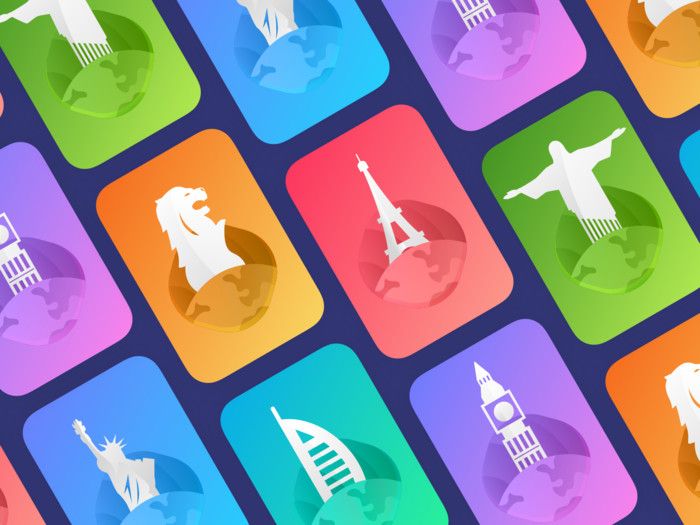
Travel apps are trending now, so don't miss your piece of the pie (image by Studio Brillo)
If you already own a business in the travel industry (for example, you’re a travel agency owner) you will also benefit after you build a travel app. Here’s how:
- You will establish a new channel to interact with your customers and sell tours right when people are using your app and are thinking about booking a tour.
- You can run in-app loyalty campaigns to activate your “sleeping” customers and generate repeat sales.
- With a Mobile App, you’re able to use some retargeting features not available for websites (e.g., sending push notifications with last-minute tours for Easter).
- Mobile applications provide you with wide analytical capabilities to make data-driven decisions in the future.
Yet, when it comes to travel app development one of the challenges is to decide on what exactly you’re building.
Are you thinking about an Expedia-like ticket/hotel booking app? Or you would like to create a travel app to explore local events, just like GetYourGuide? Or maybe you plan to develop something like Google Trips?
Since you haven’t shared your idea with us (but we strongly suggest doing this after you finish reading 😄 ) we decided to divide all the features into a few logic blocks. Therefore, you can get an idea of what your app will look like by choosing and combining only those blocks that you need for your Project.
📱 Mobile Travel App Development: Your Features List
Basic Block: Registration, Profiles, Push Notifications, Payment Gateway ⚙️
These are common features that don’t depend on the type of application and should be in your MVP-Backlog in almost any case.
Sign Up + Profiles 🔐
Sign Up is a core piece of functionality that allows users creating personal profiles in your application. Here are a few important tips from our own experience:
- People hate long Sign Ups so ask only the most essential info. The less you ask, the more users will actually create profiles. If your business model allows it – avoid using passwords, and provide your users with the option to use a Passwordless Login, e.g. using Auth0 or Firebase.
- Social Login is a must-have. It allows reusing personal information from social media just in a few taps.
- Never ever make a mandatory Sign Up for using the app. Ask for this only when it’s really needed (for example, at the checkout stage) but leave an option to checkout without creating a profile as well.

You may take this Sign Up Screen as an example since it doesn't ask for useless info and has a Social Login feature (image by Sahil Vhora)
However, your users should understand that for providing some of their personal data (even if it’s just a name and an email) they’ll get benefits. On the other hand, User Profiles will be useful for your business, too.
For example, users are able to store and quickly reuse their data in the future (for example, the credit card or passport number). On the other hand, it makes possible to analyze users’ behavior patterns and preferences to make personalized offers to your customers.
Push Notifications 🔔
This is the feature we include in our every “how-to” article since it’s a powerful tool to establish a deep personalized connection with the user, increase sales and retarget your customers. Here a few ideas of how you can use them during your travel app development:
- To introduce new tours, price changes, discounts, special/seasonal offers, etc.
- To retarget customers that left at the checkout stage without finishing their purchase or booking, so-called abandoned carts.
- To improve Customer Experience by promptly informing about booking changes, scheduled flights, and activities, etc.
Push Notifications are also one of the most noticeable advantages of mobile apps over websites since they allow delivering some information to the audience even when they aren’t using your app.
Payment Gateway 💳
If you plan to handle in-app transactions (and you probably do) you can’t go far without a good Payment Gateway. What do we mean by “good”?
- It should be consistent with all your products: a website and both Android and iOS apps.
- It includes all the most popular payment options – to pay with a credit card, Apple Pay & Google Pay, PayPal, etc.
- It works fast and without any delays.
- It’s easy to integrate their SDK into your App’s Technical Stack.
- It’s protected enough so users may not worry about their personal data, especially the one regarding their bank accounts.
Reaching these 5 points will be enough to cover customers’ expectations and make sure that nothing goes wrong during the last step of your buyers’ journey.
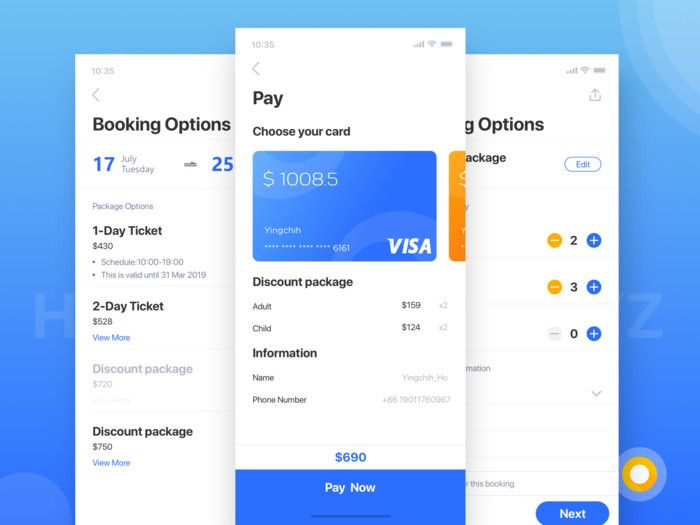
Make sure your app has a smooth payment flow (image by HYZ)
Booking Block: Transport / Hotel / Tour Booking + Car Rental ✈️
If you plan to make your own travel app with booking functionality, it’s going to be the main monetization source of your product.
Transport Booking 🚉
This feature should be on your must-have list if you want to create a travel app like Expedia or Omio. As a rule of thumb, transport travel apps choose between 2 following models: they either focus on flights and sell plane tickets or pick a wider focus and include bus & train options as well.
The booking flow consists of such steps:
- Users search date (or date range) and destination.
- Then they’re able to choose between different airlines, railway and bus companies that match the search request.
- If a suitable option is found, users can make a booking right away as well as pay for it via your payment gateway.
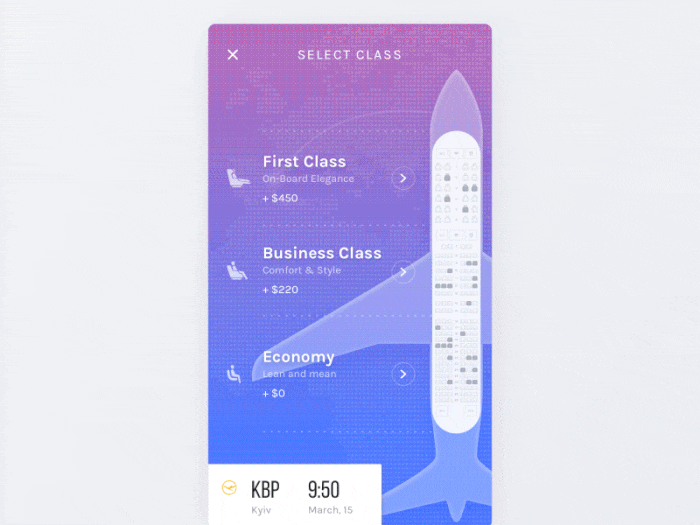
That's how a User-Friendly transport booking flow looks like (image by Vitaly Rubtsov)
Our key recommendation here is that you should include as many transport services providers as possible. The more options your users will have, the higher chances to find suitable variant are. For this you’ll have to integrate their APIs – by the way, it’s something we can help you with!
Hotel Booking 🏨
Another feature you’ll need to develop a mobile travel app like Expedia is Hotel Booking. Actually, it all stays the same as in the previous case – users search by date & destination, pick a suitable option and book their stay.
However, the major difference here is that your dev team will have to pay more attention to the Catalogue – the screen on which hotels that match search requests are shown. Every hotel should have its own screen with description, HD photos, amenities to attract tourists.
Car Rental 🚘
Car rental services are often used by tourists and that’s why you can find such a feature in many travel apps. The whole flow consists of such steps:
- Travellers either enter the location manually or use GPS to define their current position.
- Then users can browse the car listing to see all available vehicles and pick the most suitable one.
- Finally, in-app payments (remember the Payment Gateway discussed a bit earlier) let users confirm the rent without leaving your application.
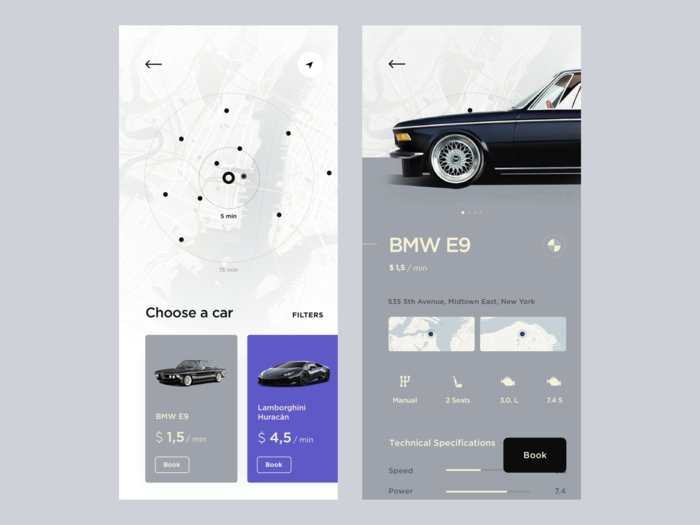
The Car Booking Feature can be found in many travel apps (image by Aufar Syahdan)
Despite it’s possible to implement peer-to-peer car rental system, we recommend partnering with established companies like Hertz, Sixt, Enterprise, and others. Thus, you’ll be able to join a branched system of car rental services all over the world and won’t have to spend much time and resources on building such a system on your own.
Tour Booking 🗽
This one is a must-have for agencies that want to make own travel app for their brand. There aren’t many examples of such applications (so it may be your competitive advantage!) but you may check Thomas Cook’s app with holiday packages or Kesari Tours.
Tour Booking is quite similar to the Hotel Booking feature with the main difference that you’re selling tours instead of rooms. However, you still need a separate screen for every holiday package where you can describe a tour program and add some bright HD photos to make it look even more attractive.
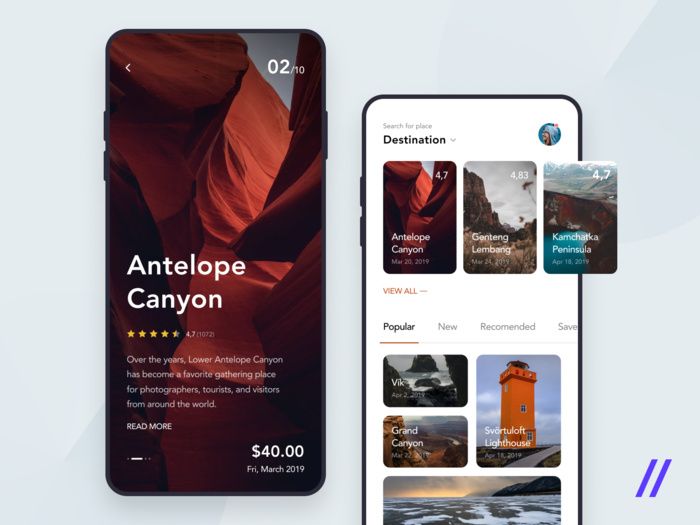
We recommend to make this Screen bright and eye-catching, just like on this pic (image by Purrweb)
Here are a few helpful tips on how you can increase the conversion rate:
- Add relevant filtering and sorting categories. For example, you may implement categories like “For kids”, “Culture” (if the tour includes many museums, art galleries, etc.), “Adventure” (if the tour is about visiting castles or walking in nature) and others. This will help users navigate through the catalog easier and increase the chances that they’ll find what they’ve been looking for.
- Include photos of places that people are going to visit during the trip to encourage booking.
Travel Planning Block: Itinerary Management, Document Holder, Real-Time Flight Alerts 🗺
Another group of popular applications for tourists includes TripIt, Google Trips and so on. So if you plan to build a travel app of such a type, here are some great features.
Itinerary Management ✍️
This is a core feature of the block. It allows organizing all travel plans and details into a streamlined itinerary so the trip is easier to manage and control:
- Users can manually add their flights, bus and train trips, hotels, restaurants, places of interest, etc.
- Also, users are able to customize their itinerary by adding descriptions, tags, photos, location addresses and so on.
To improve this feature, you may show the places from the itinerary list on the in-app map. Thus, will be able to build and save directions and routes to easily navigate between all locations.
Document Holder 🗄
If you check any planner mobile app for travellers, you’ll find out that a great deal of them allow storing tickets, booking confirmations and other travel documents to grant quick access even when users are offline.
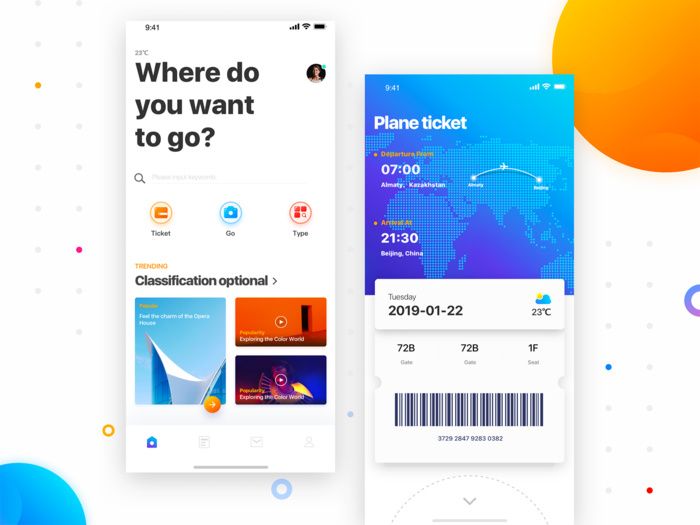
Being able to access tickets right in the app is a must-have (image by Aimm)
Real-Time Flight Alerts 🚨
Information about flight changes is something that may save one’s vacation. For example, the TripIt app notifies users when the flight is delayed or when the gate is changed.
Another good thing is that such Flight Alerts don’t require many resources to be implemented. All you have to do is to find an appropriate API (look for them at the “Tech Stack” part of this article) and integrate it into your application.
Discover Block: Users’ Reviews 💬
We all are aware of Tripadvisor’s success. Tourists often rely on reviews from other travellers when choosing where to eat or what to visit. Therefore, such functionality has high chances to be actively used by your audience as well.
Thus, you may create a separate screen where tourists may search for places to check their rating and reviews from other visitors. Except for users reviews, your audience also expects to see some basic info like address and operating hours.
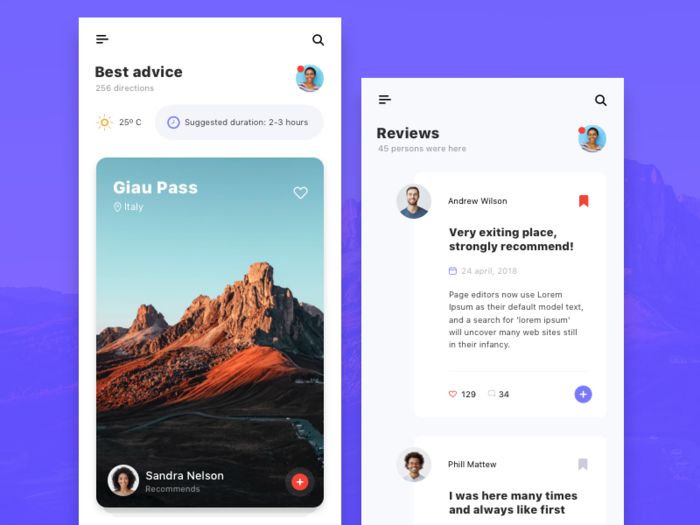
Reviews can add some value to your app (image by Sergey Belenko)
The list of places usually includes:
- hotels;
- restaurants;
- landmarks and sites.
The good news is that you can implement TripAdvisor API to reuse their data (ratings and reviews) instead of building it from scratch.
Activity Booking Block: Local Experience, Events, and Free Walking Guides 🏄♀️
Along with the “classic” sightseeing more and more people prefer to discover new destinations through local activities, whether it’s a pub crawl, a biking tour or a traditional dinner show.
How can it be implemented? Take the GetYourGuide app or Airbnb’s Experience section as examples when you create a travel app:
- Users search for destination and date (to see special events like concerts, conferences and so on).
- Then they can surf through the list of available activities and flip through them for more detailed info (for example, a brief description of the event, its duration, the guide’s languages, what’s included and what’s not, etc.).
- Finally, they should be able to pay for the activity right in the app.
{ rel="nofollow" .default-md}*)](https://cdn.sanity.io/images/ordgikwe/production/6b509da60acb04b854eb7f5c00934d71956c091a-700x525.jpg?w=700&h=525&auto=format)
The Travel Experience Screen may be a part of your monetization strategy (image by Yi Li)
It’s also possible to build your monetization strategy around this feature since you may charge some commission as a booking fee. However, this isn’t the only option. Alternatively, you may charge a fee from companies that would like to post their activities in your application or offer them a subscription-based model.
Free Walking Tours 🚶♂️
If you want to make own travel app for independent travellers free walking tours are something they expect to see. The example of such a feature you may see in the the Google Trips app or the HOTSGO PLAN application.
Basically, this is nothing more than pre-made walking guides (usually 1-3 for popular journey destinations) that include the most popular city’s landmarks.
As a rule of thumb, such guides are free so we advise using it to attract more customers but not as a part of your monetization strategy.
Extra Value Block: Weather, Tips, Currency Converter, and Many Others 👍
These are the features that can hardly be linked to any other category. Frankly speaking, there is no need to build a travel app with them all at once. However, some of them may turn out to be quite useful for your project depending on its type and expectations of your audience.
Local Tips 💭
To provide even more value to your audience, we may recommend you developing the Local Tips screen. Something similar is implemented in the Google Trips application, so you may check it out to have a clearer perspective.
What can they include?
- Food & Drinks – some local and traditional dishes and beverages that are must-try.
- Shopping – what the main malls, shopping districts, and markets are, where to find cheap and good souvenirs, etc.
- Transport options – easiest and cheapest ways to get to and from train stations and airports, specific features of public transport (e.g. operating time, night buses, available tickets, and travel cards).
- Emergency and helpline numbers – despite we all hope your audience won’t need this feature, having a short list of local helpline numbers may literally save someone’s life or purse.
Weather 🌤
Weather forecasts don’t match the MVP-Backlog but may be introduced with future updates. However, this feature provides some value both at the trip planning stage (especially when you’re packing your suitcases) and during the journey.

A great UI is one of the most important things for your Weather Screen (image by Dasha Malvo)
To develop a mobile travel app with the Weather Screen you don’t need that much:
- First, since the aim of this screen is pretty straightforward – you just have to present weather data to users – the main focus here should be on a nice-looking UI.
- Second, to make it work you’ll have to integrate a weather data API (top 5 of them are listed in our article on this topic).
Discounts 📉
Looking back again at the Google Trips app, we can’t help but recommend you to create a travel app with local discounts.
This usually relates to local tours and activities, airport transfers, taxi and car renting services – everything that may be highly relevant to travellers.
You may also try to improve this feature and introduce a Groupon-like service which allows people to get even more discounts for a small fee.
Currency Converter 💹
Just like the Weather Screen, the Currency Converter doesn’t match the MVP-Backlog but provides some additional value to your customers.
As in the previous case, to build a travel app with the Currency Converter you will need to integrate an appropriate API and fit this feature into a beautiful UI.
🗃 Case Study: Voya, Tangery, Expedia, GetYourGuide
Voya (Stomotion’s Client)
Voya is the Expedia-like application but for business travels that was developed with the support of our team. Its services include a convenient accounting and billing processes, live-reporting and date guideline management.
The booking process looks as follows:
- User requests a flight or a hotel through the Voya Chat.
- After the request is placed, travel agents (nowadays even an AI) pick the best options considering the journey budget and other preferences.
- When the user confirms, he may sit back and relax. Voya’s professionals will send the booking confirmation, boarding passes, and the calendar entry.

Shots from the Voya App
By the way, the transport options in the Voya app include not only flights but train and rental car connections as well. So if you have an idea of creating an Expedia-like travel application and need some assistance, we’re ready to share our expertise!
Tangery (Stormtion’s Client)
Tangery is an event-planning application that can be widely used during journeys as well. What are its core features?
- Users can build their itineraries by adding flights, transportation, activities, and accommodations to the specific event (“My trip to Spain”, for example).
- Moreover, it’s possible to particularize journeys by adding descriptions, photos and setting times. Also, you can see all the scheduled/planned destinations on the in-app map.
- Finally, users can chat and create shared photo albums.
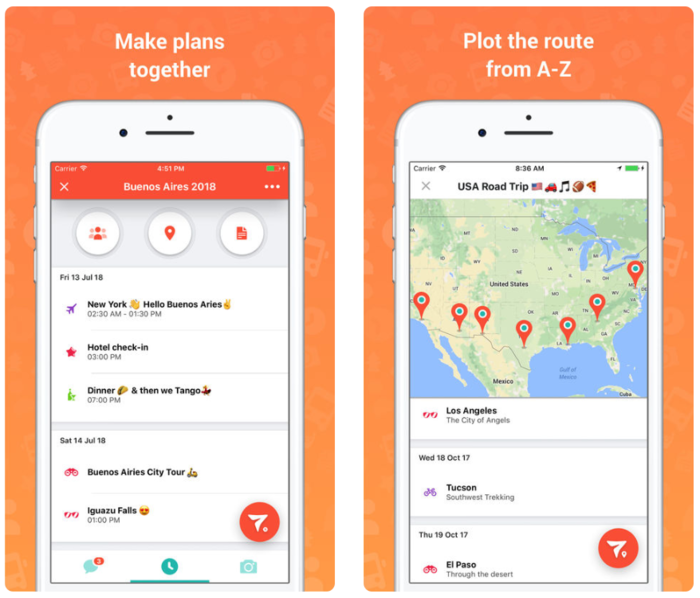
Shots from the Tangery App
Of course, users can access their itineraries offline – just like in any other travel-planning application. And if your idea is based on a similar concept, we’re here to help!
Expedia
Expedia is one of the most popular mobile apps for travellers. It focuses on providing a user-friendly way to booking flights, hotels, cars and local activities.
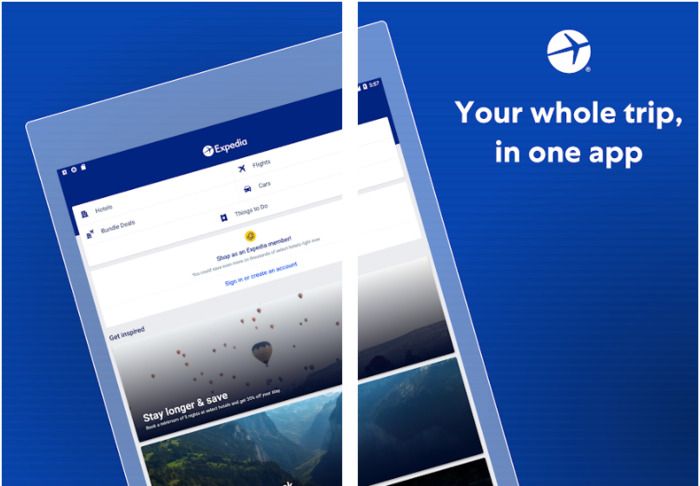
The Expedia App
So what’s the most noticeable about Expedia?
- On the Hotel Booking Screen, users can see available options both as a list or pick them on the interactive in-app map.
- There is also a “Get Inspired” section where users can find $99 or less, 24-hour and last-minute deals.
- Except for booking features, Expedia also allows saving your itinerary that may include hotels, flights, and activities booked through the app.
GetYourGuide
If you’re thinking about developing a travel app for booking local activities, GetYourGuide will be a good case to learn. What do we like about it?
The category system is quite clear and helpful – users can choose between Food, Adventure, Culture, Sightseeing, Art and music, Nature and so on. Despite the same site or activity may be in a few categories at the same time, it makes the whole navigation easier and increases the chances that people will find what they’re looking for.
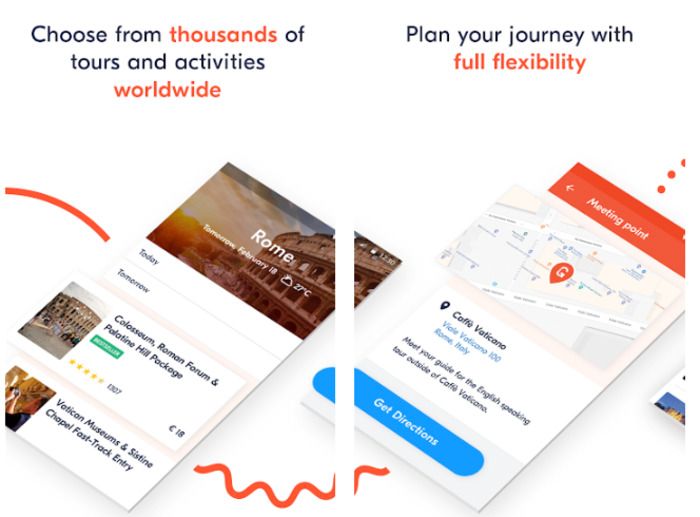
The GetYourGuide App
Also, the Activity Screen is of top-notch quality. It’s noticeable because of its nice UI and comprehensive information about the offer which includes:
- Several photos to attract attention and visualize the activity.
- An exact price.
- A short description with key info – duration, cancellation policy, wheelchair accessibility, pick-up services, the guide’s spoken languages, etc.
- A detailed description of the activity itself (what people will visit and what will they do there).
- Ratings and reviews of the activity from other users.
As a small bonus, the app also shows the current weather in the chosen city.
👨💻 Travel App Development Approaches
Ok, let’s imagine that now you have a clear vision of your future app. Yet, you still have to turn your ideas into a working software product. Possible 3 ways to do it are:
- App Builder.
- In-House Development.
- Outsourcing.
Let’s briefly review the pros and cons of each solution.
App Builders
App builders are online development tools that allow creating mobile applications with no coding knowledge. All you have to do is to open the website and assemble your application from different screens, features, and blocks like a puzzle.
Pros:
- You can build an application on your own without any mobile development experience.
- It takes less time than any other development approach.
- Despite app builders charge some fees, the overall spendings are lower compared to outsourcing or in-house development.
Cons:
- App builders offer you quite a limited number of customization possibilities, so you’ll get a simple templated app with poor UI and UX.
- Also, not all features are available when you make own travel app using app builders.
💡 Conclusion: despite it may be fast and cheap, we don’t recommend to develop a mobile travel app using such services if you’re aiming to build a business, due to the poor results.
In-House Development
The In-House Dev Approach is based around the idea of building your own full-time development team. This option has both positive and negative sides and here they are:
Pros:
- You will create a dedicated team that is fully focused only on your project.
- Direct supervision allows you to plan the schedule of your in-house team, assign task and make sure that everyone is on the right place.
Cons:
- You will have to build the team from scratch and it’s much more than putting a few people in one room. Actually, they should work as a single unit supervised by a CTO. Thus, it may take months.
- Prepare to face more additional expenses since you’ll have to rent an office, purchase technical equipment, cover health insurance, and vacations, etc.
- Your In-House team requires a long-term development plan and a Backlog that is regularly filled up. Otherwise, you may find yourself in the situation when your developers run out of tasks and have nothing to do.
💡 Conclusion: In-House approach will take a lot of time and resources and makes sense only once the business model is validated and you’re planning long-term development.
Digital Agency
Finally, you may outsource your mobile travel app development to a Remote Dev Team. Such solution helps you to get rid of the development “headache” without making you create your own team from scratch.
In a nutshell, outsourcing is about finding a Remote Team, creating a Dev Roadmap together with them and delegating all the tasks to that team. At the same time, you can supervise the development and guide it in the needed direction.
What are the pros and cons of outsourcing? Here they are.
Pros:
- When outsourcing, you hand your Project to the balanced team of professionals. Thus, they have all Agile ceremonies and the dev process set up and well-organized.
- Flexibility is another advantage. If you wish, you can just write the requirements and wait until the job’s done. But it’ll be also ok if you’d like to supervise each step. So you may choose the best option.
- This is the best option regarding the price-quality ration. On the one hand, you’ll get a native mobile application with a user-friendly UX and UI. On the other hand, you don’t have any extra expenses since you pay only for the completed work.
- It’s far easier to iterate, as you don’t have the pain of managing a dev team and can fully focus on Product Development, Customer Interviews and Fundraising.
Cons:
- Dev Agencies aren’t interested in working on small projects (like bug fixing or adding a single screen). Thus, you have higher chances to partner with such an agency in terms of the full-scale mobile travel app development.
- Comparing to just having a technical co-founder (who is likely motivated just by equity) or a business partner, this option is more expensive as you have to invest cash in the development.
💡 Conclusion: Outsourcing is one of the best options to consider on the early stages since it provides a scalable end-to-end development solution at a reasonable price.
🛠 Tech Stack
As we promised before, here are some technical tools that will help you make own travel app:
- To get data about available flight options you may use Skyscanner, Travelopro or Trawex APIs. You may also access APIs from different flight companies like Lufthansa.
- ZUMATA Hotel Booking API or Expedia Affiliate Network API are tools that will help to implement the hotel booking functionality.
- To implement flight alerts, you may use Alerts API.
- OpenWeatherMap, AccuWeather and Weather Underground are some of the best APIs when it comes to collecting weather data.
- If you’re looking for proven Payment Gateways, pay attention to the following options: Android Pay, Apple Pay, PayPal, Stipe and Braintree APIs.
- To implement the Social Login you may use Twitter, Instagram or Facebook Mobile SDKs. To provide such options as SMS-auth or paswordless email authorization use Auth0 or Firebase.
- One of the top Push Notifications providers are Firebase Cloud Messaging (used by our team as well), OneSignal (this one too), Urban Airship and Amazon SNS.
💰 Cost to Build a Travel App
Here's our estimate of travel app development costs:
MVP Features Estimated in Hours
Using React Native
⚙️ Features | ⏳ Min Hours | ⏱ Max Hours |
|---|---|---|
🛠 Setup Technical Foundations | 6 | 10 |
👋 Onboarding | 8 | 12 |
🔐 Sign Up Flow | 48 | 60 |
Sign up | 20 | 24 |
Forgot Password | 8 | 12 |
Social Login | 20 | 24 |
📝 Booking Flow | 240 | 286 |
Flight booking | 72 | 84 |
Hotel booking | 64 | 76 |
Car rental | 56 | 66 |
Tour booking | 48 | 60 |
🗓 Travel Planning Flow | 90 | 112 |
Itinerary management | 60 | 72 |
Document holder | 30 | 40 |
🗺 Discover Flow | 90 | 114 |
In-app map | 60 | 74 |
Reviews | 30 | 40 |
🏄♂️ Activities Flow | 90 | 112 |
Local Experiences & Events | 50 | 60 |
Free Walking Guides | 40 | 52 |
💸 Payment Flow | 48 | 60 |
🔔 Push Notifications | 24 | 30 |
⏱Total Hours | 644 | 796 |
💵Approximate costs | $28,980 | $31,840 |
So the approximate cost to build a travel app like Expedia is about $29-36,00. However, we don't think that building such an "everything-in-one" app is a good point to start. Actually, such major pieces of functionality as hotel booking or car rental can be implemented within separate applications.
To calculate the costs of travel app development we took an average for Eastern Europe rate of $45/hour. However, to get a more accurate estimate (which will be likely lower) we need some more information about your project. Share it by contacting us and we'll prepare a precise estimate just for you!
💡 Takeaways
Whew, we’ve finished. Our Team hopes that you will use this in-depth article as your guide to mobile travel app development to revolutionize the travel market. Let’s briefly recall all key steps:
- Clearly define what are you building: type, main functionality and the target audience of your application and how it solves problems of your customers.
- Fill the Development Backlog with features, choosing only those that match your MVP. Remember, your app shouldn’t be able to do everything – it just needs to solve the pain of your users better than any other app out there.
- Find the right Tech Partner (whether you’re building an In-House Team or Outsourcing your development).
- Get things done!
Stormotion Team can help you with travel app development – we can develop an MVP or a PoC for you, validate your business model, scale your Product or act as an interim-CTO.
Was it helpful?
Read also

How to Create a Fitness App: Process, Costs, Estimates and Challenges

What is Prototyping in IoT and Some Practical Advice

What is IoT Device Management?
Our clients say
![Stormotion client Alexander Wolff, CPO from [object Object]](/static/a16ba3c9580effc3ab9a68d115eadffe/b0e74/alex.png)
When I was working with Stormotion, I forgot they were an external agency. They put such effort into my product it might as well have been their own. I’ve never worked with such a client-focused company before.
Alexander Wolff, CPO
Sjut
